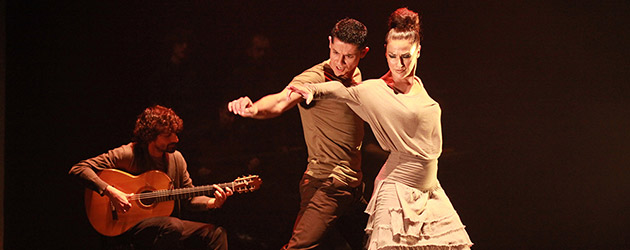Text: Estela Zatania
Photos: Ana Palma
Adela Campallo & Rafael Campallo «Sangre»
Monday, March 2nd, 2015. Jerez de la Frontera
Special 19th Festival de Jerez – All the information
At 7 pm Monday at the Festival de Jerez, two very Jerez-sounding female voices shared an acoustic recital at the Palacio Villavicencio. With an all-Jerez backup, the guitar of Miguel Salado and the palmas of Manuel Salado and Carlos Grilo, Tamara Tañé sang with her caramelized voice in the style of her generation that owes so much to Remedios Amaya. Eva Rubichi, with the guitar of her husband Dominngo Rubichi, used her sweetly rough-hewn delivery to interpret cante from her neighborhood of San Miguel, making use of her ability to turn lyrical song into flamenco via bulerías. As Eva said in her press conference: «I've lived it in the street, the flamenco associations and fiestas of Jerez». The recital was dedicated to young guitarist Barullito of the Moneo family who passed away just a few days ago.
Video Eva Rubichi – Video Tamara Tañé
Photo Eva Rubichi – Photo Gallery Tamara Tañé
The eloquent silence of Rafael Campallo
ADELA & RAFAEL CAMPALLO «SANGRE»
Teatro Villamarta, 900pm
Dance: Rafael Campallo, Adela Campallo. Special collaboration: Begoña Arce, Hugo Sánchez, Carmen Ledesma. Guest artist: Raúl Gómez. Cante: Enrique Extremeño, Jesús Corbacho, Londro. Guitar: David Vargas, Juan Campallo. Percussion: Raúl Botella, Javi Silva. Choreography: Rafael Campallo, Adela Campallo. Artistic director: Mercedes de Córdoba. Music director: Juan Campallo.
At the Villamarta theater, we had the opportunity to see an interesting collaboration between two brothers and their sister: dancers Adela and Rafael Campallo, with the guitar and musical direction of Juan Campallo. I don't know if the title «Sangre» ('blood') is a wink to the most radical gypsyphiles who only understand flamenco as strands of DNA, but the thing is, many of those who do not belong to that ethnic group have their own flamenco ambience, live flamenco as a family tradition and express themselves through their shared art. In fact, there are other brother and sister dancers nowadays, most notably Israel and Pastora Galván, and Juan and Pilar Ogalla, but they have done relatively few things together on stage.
This work, «Sangre», begins with elements of classic flamenco presented with an openly retro feeling. It's the ongoing need of the current generation to distance itself from the rose between the teeth and polkadots, while at the same time that everything done in the name of contemporary flamenco derives from that which went before, a sort of love-hate relationship. In this line, Rafael interprets the purest flavor of tangos de Triana with a brief dance, without the tiresome exaggeration others resort to: his understated stops and eloquent silences are worth more than the over-the-top routines so many dancers whip up seeking easy applause. It's hard to imagine this dancer gives so little importance to what he commands so thoroughly. Technique can be acquired by almost anyone with enough hours at the studio, but the magic Rafael Campallo effortlessly constructs thanks to his exquisite good taste and the knowledge acquired from his maestros, particularly the compact and intense Manolo Marín, is simply priceless.
Dancer Carmen Ledesma contributed another perspective that could be considered authentic, with the added attraction of the singing of Enrique Extremeño and Adela's fiesta dancing. They do a short skit of «scolding» the guitarist for playing too fast, since what they want is the rhythm of «romance», or «bulerías al golpe» as it's called in Lebrija, that delightful alternative to the Jerez approach and which is so popular inland.
The two singers, Londro and Jesús Corbacho, trading off fandangos, gave a welcome alternative to the typical tonás. Another noteworthy moment was the farruca danced by Rafael with Raúl Gómez, fascinating with its disciplined controlled line recalling the best moments of Mario Maya with El Güito. Sobriety, aplomb and minimalism to express expansive concepts. Men's flamenco dance at its essence.
Also admirable was the guitar and original music of Juan, the third Campallo involved in the work.
